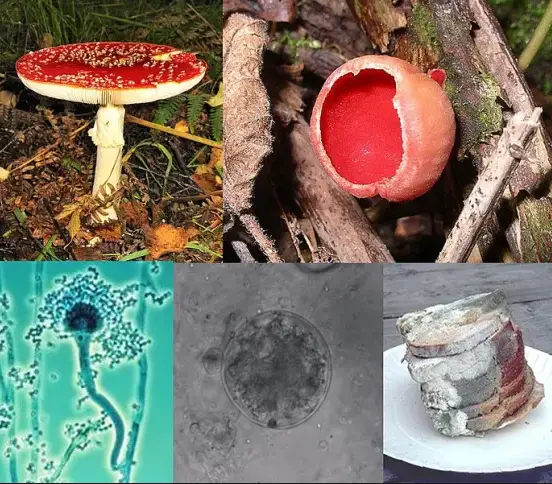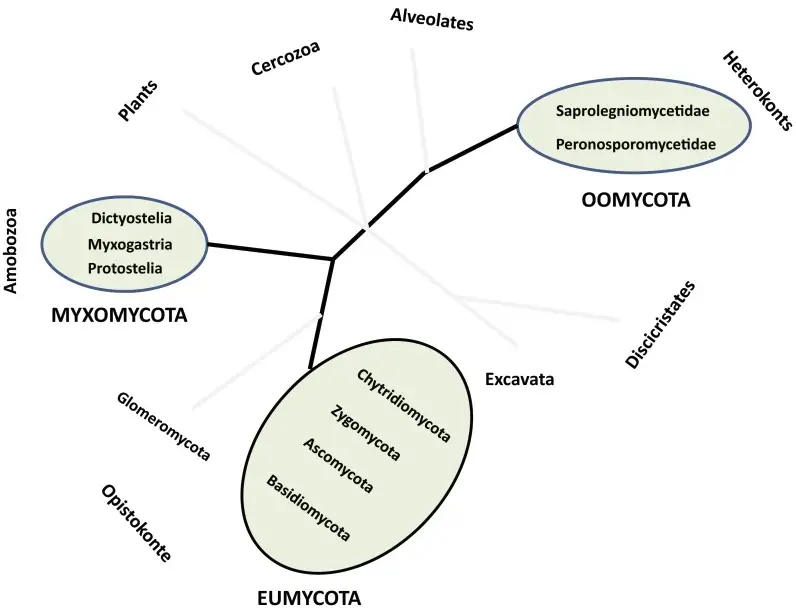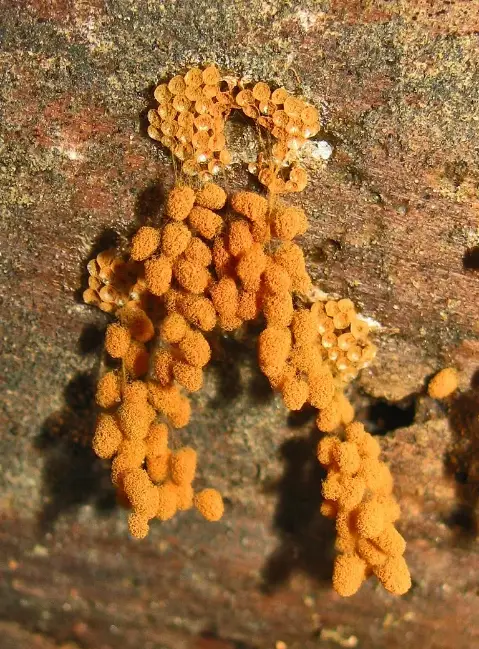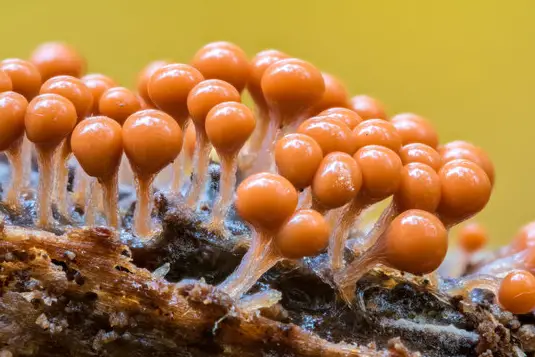The kingdom of fungi presents a fascinating diversity, exemplified by two of its members: Myxomycota and Eumycota. These groups, while both classified under the broader umbrella of fungi, exhibit distinct differences that have significant implications for their biological classification and roles within ecosystems. This distinction not only highlights the complexity of life forms but also underscores the importance of taxonomy in understanding biological relationships and functions.
Myxomycota, commonly known as slime molds, are peculiar organisms that blur the lines between fungi and amoebae, primarily thriving in moist, shaded environments. Eumycota, or true fungi, encompass a vast range of species including molds, yeasts, and mushrooms, which are crucial for ecological balance and human industry. Despite their shared kingdom, Myxomycota and Eumycota differ fundamentally in their lifecycle, structure, and genetic makeup, which affects their ecological roles and applications.
The exploration of Myxomycota and Eumycota opens a window into the complexity of fungal biology and its evolutionary nuances. These differences are not just of academic interest but have practical implications in biotechnology, agriculture, and medicine, reflecting their unique adaptations and capabilities within various ecosystems.

Taxonomy Overview
Myxomycota Basics
Definition and Characteristics
Myxomycota, often referred to as slime molds, are intriguing organisms that sit on the borderline between fungi and amoebae. These organisms exhibit unique traits that set them apart from typical fungi. Unlike their fungal cousins, Myxomycota possess the ability to move during their plasmodial stage, where they appear as slime-like entities capable of crawling. They thrive in moist environments, feeding on microorganisms and organic debris through phagocytosis, a trait not commonly associated with other fungal types.
Life Cycle Specifics
The life cycle of Myxomycota is fascinating and complex. It begins with spore germination, leading to the formation of swarm cells or myxamoebae, which can either replicate asexually or fuse to form a zygote. This zygote develops into a multinucleate, mobile plasmodium, which is a hallmark of the Myxomycota group. Under unfavorable conditions, the plasmodium differentiates into a fruiting body, culminating in spore release, thus completing the cycle.
Eumycota Basics
Definition and Characteristics
Eumycota, or true fungi, comprise a vast and diverse group known for their rigid cell walls made from chitin. These organisms are quintessential decomposers in the ecosystem, breaking down complex organic materials to simpler forms. Eumycota are characterized by their thread-like structures called hyphae, which form complex networks known as mycelium. This structure allows them to absorb nutrients from a wide variety of substrates, ranging from soil to decaying matter.
Reproductive Mechanisms
Eumycota reproduce through sophisticated mechanisms involving both sexual and asexual processes. The asexual reproduction typically occurs via spore formation, where spores are produced externally on specialized structures or within sporangia. Sexual reproduction involves the fusion of hyphae from different mating types, leading to the formation of spores that genetically vary from their parents, contributing to genetic diversity.
Ecological Roles
Myxomycota in Nature
Habitat and Distribution
Myxomycota are predominantly found in moist, shaded forest areas where they inhabit the surfaces of decaying wood, leaf litter, and other organic materials. Their presence is critical in these habitats as they contribute to the decomposition process and nutrient cycling.
Ecological Importance
The ecological role of Myxomycota extends beyond mere decomposition. These organisms are also essential in the food web, serving as a food source for microscopic invertebrates. Moreover, their ability to move and consume bacteria and fungi plays a significant role in controlling the microbial population, thereby maintaining ecological balance.
Eumycota in Nature
Habitat Diversity
Eumycota are remarkably versatile and can inhabit a range of environments from soil and water to extreme environments like deserts and arctic tundra. This adaptability allows them to play various roles across different ecosystems.
Role in Ecosystems
The primary role of Eumycota in ecosystems is decomposition, but their impact extends to symbiotic relationships with plants (mycorrhizae), aiding in nutrient uptake. Furthermore, some species are pathogens to plants and animals, significantly affecting agriculture and natural ecosystems.

Morphological Differences
Cellular Structure Comparison
When comparing the cellular structures of Myxomycota and Eumycota, significant differences are observed. Myxomycota lack a typical fungal cell wall during their plasmodial stage, which allows for their unique motility. In contrast, Eumycota maintain a rigid structure due to their chitin-based cell walls, essential for their role in absorption and support.
Spore Formation Processes
The processes of spore formation also highlight critical differences. Myxomycota spores are formed aerially or within the confines of a fruiting body, adapted for dispersal via air or water. Eumycota, however, often form spores at the tips of their hyphae or within special structures that can survive harsh environmental conditions.
Genetic Makeup
Chromosomal Distinctions
Genetically, Myxomycota and Eumycota differ in their chromosomal setup. Myxomycota generally have a simpler genetic structure, which is apparent during their lifecycle phases. Eumycota’s genetic material is more complex, reflecting their more elaborate lifecycle and reproductive strategies.
Impact on Classification
These genetic differences have profound impacts on their classification. While both are placed under the kingdom Fungi, Myxomycota’s unique characteristics sometimes lead to debates among scientists about their exact placement. Understanding their genetic makeup helps clarify these taxonomic distinctions and aids in better classification systems.

Practical Applications
Myxomycota Uses
Research and Biotechnology
Myxomycota have become a focal point in scientific research, particularly in studies related to cell motility and signaling. Their unique ability to oscillate between single-celled and multicellular stages provides valuable insights into cellular processes such as chemotaxis, which is the movement of cells in response to chemical stimuli. In biotechnology, Myxomycota’s enzymes are exploited for their efficiency in breaking down organic materials, which can be applied in waste management and sustainable energy production, such as biofuel development.
Other Industrial Uses
Beyond the lab, Myxomycota have practical applications in various industries. For instance, their natural capacity to decompose organic matter is harnessed in composting processes, improving the efficiency and speed of organic waste decomposition. Additionally, certain compounds derived from Myxomycota are under research for their potential use in manufacturing biodegradable plastics, offering a sustainable alternative to traditional polymers.
Eumycota Uses
Pharmaceutical Contributions
Eumycota are invaluable to the pharmaceutical industry. Many antibiotics, such as penicillin, are derived from fungi within this group. Moreover, Eumycota are a source of statins, used widely to lower cholesterol and reduce the risk of heart disease. Their diverse metabolic pathways allow scientists to engineer fungal strains that can produce a variety of therapeutically relevant biochemicals.
Agricultural and Food Industry
In the agricultural sector, Eumycota play a critical role in enhancing soil fertility through their symbiotic relationships with plants, notably in the formation of mycorrhizae. This symbiosis increases water and nutrient absorption, boosting plant growth and crop yields. In the food industry, fungi like yeasts (a subset of Eumycota) are essential for the production of bread, beer, and wine. Their enzymatic activities are crucial for fermentation processes, impacting flavor, texture, and nutritional value.
Challenges in Study
Identification Challenges
Identifying and classifying Myxomycota and Eumycota pose significant challenges due to their diverse morphologies and life cycles. Traditional methods, which often involve microscopic examination and culture techniques, can be insufficient for certain species that exhibit unique or cryptic life stages. Molecular techniques, such as DNA barcoding, have improved accuracy but are not universally accessible due to cost and technical expertise requirements.
Current Research Methodologies
Modern mycological research relies heavily on a combination of field studies, laboratory experiments, and computational models. Techniques such as next-generation sequencing and bioinformatics are increasingly used to understand fungal genomes and their complex interactions with the environment. These methods help in deciphering the evolutionary pathways and ecological roles of fungi, providing a deeper understanding that informs both taxonomy and practical applications.
Future Directions
Technological Advancements in Study
The field of mycology is rapidly evolving, driven by advancements in technology. Imaging technologies like confocal microscopy provide three-dimensional views of fungal structures at cellular and subcellular levels, offering insights that were previously unattainable. Furthermore, CRISPR gene editing and other biotechnological tools are being adapted for fungi, allowing for precise manipulations of their genetic material, which could revolutionize how fungi are used in industry and medicine.
Potential Discoveries and Implications
Looking ahead, the potential discoveries in the study of Myxomycota and Eumycota are vast. Researchers are exploring the use of fungi in bio-remediation to clean up contaminated environments, including oil spills and heavy metal pollutants. Additionally, the unique properties of fungi are being tapped into for developing new materials, such as fungal-derived leather alternatives, which are more sustainable than traditional materials. The implications for sustainability and environmental conservation are profound, highlighting the importance of fungi in future scientific and industrial advancements.
Frequently Asked Questions
What are Myxomycota?
Myxomycota, or slime molds, are a group of fungus-like organisms that exhibit characteristics of both fungi and amoebas. Unlike typical fungi, slime molds thrive in moist environments and can move during certain stages of their lifecycle, presenting unique behaviors like phagotrophy.
How do Eumycota reproduce?
Eumycota reproduce through a variety of mechanisms, including both sexual and asexual reproduction. They can form spores that are either released into the air or remain enclosed within a fruiting body, depending on the species and environmental conditions.
What roles do Myxomycota play in the ecosystem?
Myxomycota primarily decompose organic matter in forest ecosystems, contributing to nutrient cycling and soil fertility. They are particularly important in breaking down complex compounds in dead vegetation, a crucial step in ecological balance.
Are Eumycota beneficial to humans?
Yes, Eumycota are incredibly beneficial to humans in many ways. They play essential roles in food production (e.g., baking and brewing), drug manufacture (e.g., antibiotics like penicillin), and biodegradation. Their enzymes and metabolic processes are also exploited in industrial applications.
Conclusion
The intricate world of Myxomycota and Eumycota highlights the vast diversity and adaptability within the fungal kingdom. These organisms not only play pivotal roles in their natural habitats but also offer valuable resources for scientific research and industry. Understanding their differences and similarities sheds light on broader ecological and evolutionary processes.
As research continues to uncover the secrets of these fascinating groups, it becomes increasingly clear that Myxomycota and Eumycota are more than just taxonomic curiosities. They are vital components of the biosphere, whose study can lead to innovations in multiple fields, from environmental management to biotechnology, emphasizing the importance of preserving and studying biodiversity.

